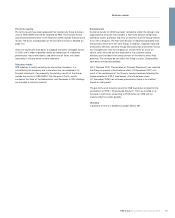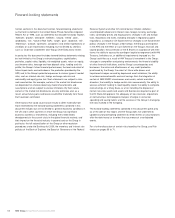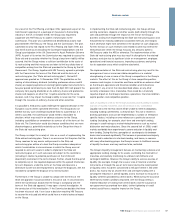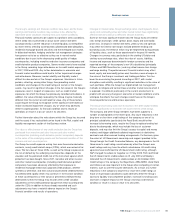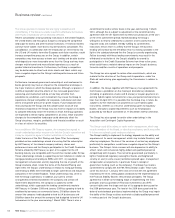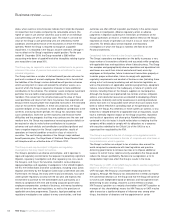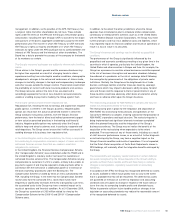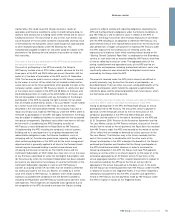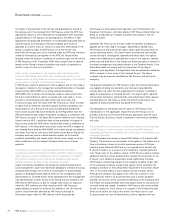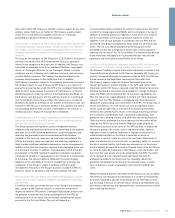RBS 2009 Annual Report Download - page 63
Download and view the complete annual report
Please find page 63 of the 2009 RBS annual report below. You can navigate through the pages in the report by either clicking on the pages listed below, or by using the keyword search tool below to find specific information within the annual report.
61RBS Group Annual Report and Accounts 2009
Business review
The Group’s ability to implement its strategic plan depends on the success
of the Group’s refocus on its core strengths and the balance sheet
reduction programme arising out of its previously announced non-core
restructuring plan and the State aid restructuring plan.
In light of the changed global economic outlook, the Group has
embarked on a financial and core business restructuring which is focused
on achieving appropriate risk-adjusted returns under these changed
circumstances, reducing reliance on wholesale funding and lowering
exposure to capital intensive businesses. A key part of this restructuring is
the programme to run down and sell the Group’s non-core assets
announced in February 2009, which targets a gross reduction in funded
assets of £251 billion, and the continued review of the Group’s portfolio to
identify further disposals of certain non-core assets. This balance sheet
reduction programme will continue alongside the disposals under the
State aid restructuring plan approved by the Commission.
Because the ability to dispose of assets and the price achieved for such
disposals will be dependent on prevailing economic and market
conditions, which may remain challenging, there is no assurance that
the Group will be able to sell or run down (as applicable) those
businesses it is seeking to exit either on favourable economic terms to
the Group or at all. Furthermore, where transactions are entered into for
the purpose of selling non-core assets and businesses, they may be
subject to conditions precedent, including government and regulatory
approvals and completion mechanics that in certain cases may entail
consent from customers. There is no assurance that such conditions
precedent will be satisfied, or consents and approvals obtained, in a
timely manner or at all. There is consequently a risk that the Group may
fail to complete such disposals by any agreed longstop date.
Furthermore, in the context of implementing the State aid restructuring
plan, the Group is subject to certain timing and other restrictions which
may result in the sale of assets at prices below those which the Group
would have otherwise agreed had the Group not been required to sell
such assets as part of the State aid restructuring plan or if such sale
were not subject to the restrictions contained in the terms of the State
aid conditions.
In addition, the Group may be liable for any deterioration in businesses
being sold between the announcement of the disposal and its
completion. In certain cases, the period between the announcement of
a transaction and its completion may be lengthy and may span many
months. Other risks that may arise out of the disposal of the Group’s
assets include ongoing liabilities up to completion of the relevant
transaction in respect of the assets and businesses disposed of,
commercial and other risks associated with meeting covenants to the
buyer during the period up to completion, the risk of employee and
customer attrition in the period up to completion, substantive indemnity
obligations in favour of the buyer, the risk of liability for breach of
warranty, the need to continue to provide transitional service
arrangements for potentially lengthy periods following completion of the
relevant transaction to the businesses being transferred and
redundancy and other transaction costs. Further, the Group may be
required to enter into covenants agreeing not to compete in certain
markets for specific periods of time. In addition, as a result of the
disposals, the Group will lose existing customers, deposits and other
assets (both directly through the sale and potentially through the impact
on the rest of the Group’s business arising from implementing the
restructuring plans) and the potential for realising additional associated
revenues and margins that it otherwise might have achieved in the
absence of such disposals.
Any of the above factors, either in the context of State aid-related or
non-core or other asset disposals, could affect the Group’s ability to
implement its strategic plan and have a material adverse effect on the
Group’s business, results of operations, financial condition, capital ratios
and liquidity and could result in a loss of value in its securities.
The extensive organisational restructuring may adversely affect the
Group’s business, results of operations and financial condition.
As part of its refocus on core strengths and its disposal programme, the
company has undertaken and continues to undertake extensive
organisational restructuring involving the allocation of assets identified
as non-core assets to a separate Non-Core division, and the run-down
and sale of those assets over a period of time. In addition, to comply
with State aid clearance, the company has agreed to undertake a series
of measures to be implemented over a four-year period, which include
disposing of RBS Insurance (subject to potentially maintaining a
minority interest until the end of 2014). The company will also divest by
the end of 2013 Global Merchant Services, subject to the company
retaining up to 20 per cent. of each business within Global Merchant
Services if required by the purchaser, and its interest in RBS Sempra
Commodities, as well as divesting the Royal Bank branch-based
business in England and Wales and the NatWest branches in Scotland,
along with the direct SME customers and certain mid-corporate
customers across the United Kingdom. In order to implement these
restructurings, various businesses and divisions within the Group will be
re-organised, transferred or sold, or potentially merged with other
businesses and divisions within the Group. As part of this process,
personnel may be reallocated, where permissible, across the Group,
new technology may be implemented, and new policies and procedures
may be established in order to accommodate the new shape of the
Group. As a result, the Group may experience a high degree of
business interruption, significant restructuring charges, delays in
implementation, and significant strain on management, employee,
operational and financial resources. Any of the above factors could
affect the Group’s ability to achieve its strategic objectives and have a
material adverse effect on its business, results of operations and
financial condition or could result in a loss of value in its securities.


